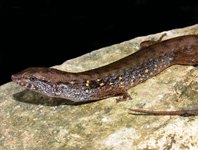Abstract
To date the genus Diploplastron comprised only one species of ophryoscolecid ciliate, Diploplastron affine, which is characterized by having two retractable ciliary zones in the anterior end of the body, two slender and juxtaposed skeletal plates on the right side, a rod shape macronucleus, and two contractile vacuoles. During study on the characterization of rumen ciliate community composition in Brazilian domestic sheep, we observed ciliates with atypical morphology but with diagnostic features of genus Diploplastron. This study describes Diploplastron dehorityi, a new species of ophryoscolecid ciliate, that differs from D. affine, primarily, in the morphology of skeletal plates, morphology of nuclear apparatus and body shape. In addition to the similarities between the new species and congener species, D. dehorityi has some morphological similarities to species of genus Eremoplastron.
References
Bush, A.O., Laffert, K.D., Lotz, J.M. & Shostak, A.W. (1997) Parasitology meets ecology on its own terms: Margolis et al. revisited. Journal of Parasitology, 83, 575–583.
https://doi.org/10.2307/3284227Cedrola, F., Rossi, M., Dias, R.J.P., Martinele, I. & D’Agosto, M. (2015) Methods for taxonomic studies of rumen ciliates (Alveolata: Ciliophora): A brief review. Zoological Science, 32 (1), 8–15.
https://doi.org/10.2108/zs140125Cedrola, F., Martinele, I., Dias, R.J.P., Fregulia, P. & D’Agosto, M. (2016a) Rumen ciliates in Brazilian sheep (Ovis aries), with new records and redescription of Entodinium contractum (Entodiniomorphida, Ophryoscolecidae). Zootaxa, 4088 (2), 292–300.
https://doi.org/10.11646/zootaxa.4088.2.10Cedrola, F., Senra, M.V.X., D’Agosto, M. & Dias, R.J.P. (2016b) Phylogenetic analyses support validity of genus Eodinium. Journal of Eukaryotic Microbiology, 64 (2), 242–247.
https://doi.org/10.1111/jeu.12355D’Agosto, M. & Carneiro, M.E. (1999) Evaluation of lugol solution used for counting rumen ciliates. Revista Brasileira de Zoologia, 85, 725–729.
https://doi.org/10.1590/S0101-81751999000300011Dehority, B.A. (1984) Evaluation of subsampling and fixation procedures for counting rumen protozoa. Applied and Environmental Microbiology, 48, 182–185.
Dogiel, V.A. (1927) Monographie der Familie Ophryoscolecidae. Archiv für Protistenkunde, 59, 1-–288.
Fernandez-Galiano, D. (1979) Transfer of the widely known “spirotrich” ciliate Bursaria truncatella O.F.M. to the Vestibulifera as a separate order there, the Bursariomorphida. Transactions of the American Microscopic Society, 98, 447–454.
https://doi.org/10.2307/3225730Göçmen, B., Torun, S. & Öktem, N. (1999) Türkiye Evcil Koyun (Ovis ammon aries)’lar›n›n ‹flkembe Siliyat (Protozoa: Ciliophora) Faunas› Hakk›nda Bir Ön Çal›flma: II- Familya Ophryoscolecidae (Entodiniomorphida). Turkish Journal of Zoology, 23 (2), 473–490.
Ito, A. & Imai, S. (2006) Infraciliary band pattern of rumen Ophryoscolecid ciliates. Endocytobiosis Cell Research, 17, 103–110.
Kittelmann, S., Devente, S.R., Kirk, R.M., Seedorf, H., Dehority, B. & Janssen, P.H. (2015) Phylogeny of intestinal ciliates, including Charonina ventriculi, and comparison of microscopy and 18S rRNA gene pyrosequencing for rumen ciliate community structure analysis. Applied and Environmental Microbiology, 81, 2433–2444.
https://doi.org/10.1128/AEM.03697-14Kofoid, C.A. & MacLennan, R.F. (1932) Ciliates from Bos indicus. II. The genus Diplodinium Schuberg. University of California Publications in Zoology, 37, 53–152.
Noirot-Timothée, C. (1960) Etude d’une familie de ciliés: les Ophryoscolecidae. Structure et ultrastructures. Annales des Sciences Naturelles - Zoologie et Biologie Animal, 12, 526–718.
Ogimoto, K. & Imai, S. (1981) Atlas of Rumen Microbiology. Japan Scientific Societies Press, Japan, 231 pp.
Rossi, M.F., Dias, R.J.P., Senra, M.V.X., Martinele, I., Soares, C.A.G. & D’Agosto, M. (2015) Molecular phylogeny of the family Ophryoscolecidae (Ciliophora, Litostomatea) inferred from 18S rDNA sequences. Journal of Eukaryotic Microbiology, 62, 584–590.
https://doi.org/10.1111/jeu.12211Wereskka, K. & Michalowski, T. (2012) The ability of the rumen ciliate protozoan Diploplastron affine to digest and ferment starch. Folia Microbiologica, 57, 375–377.
https://doi.org/10.1007/s12223-012-0146-1Williams, A.G. & Coleman, G.S. (1992) The rumen protozoa. Springer Verlag, New York, 450 pp.
https://doi.org/10.1007/978-1-4612-2776-2

